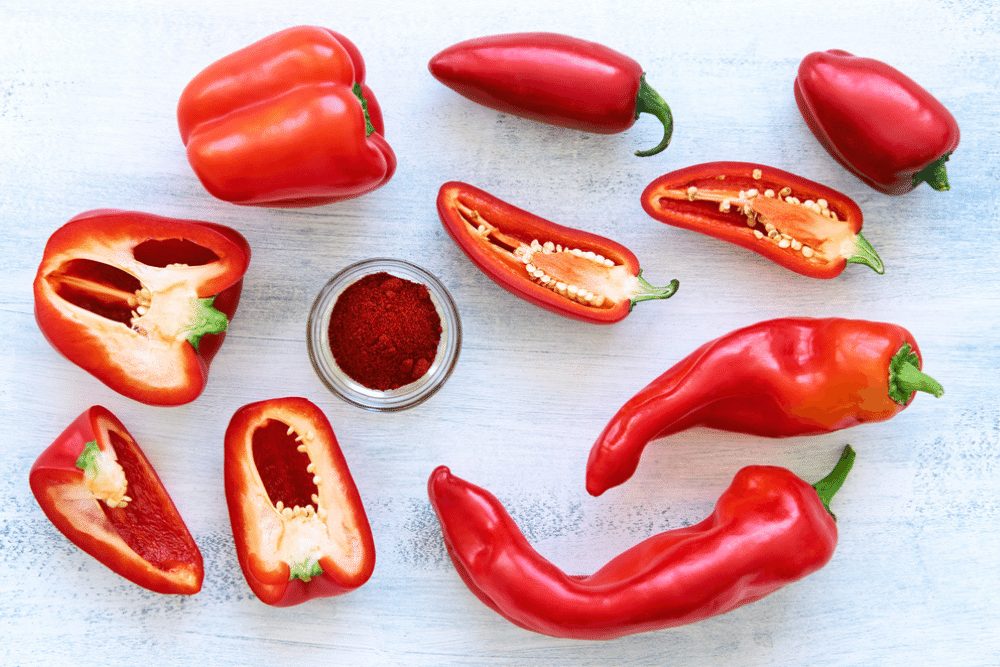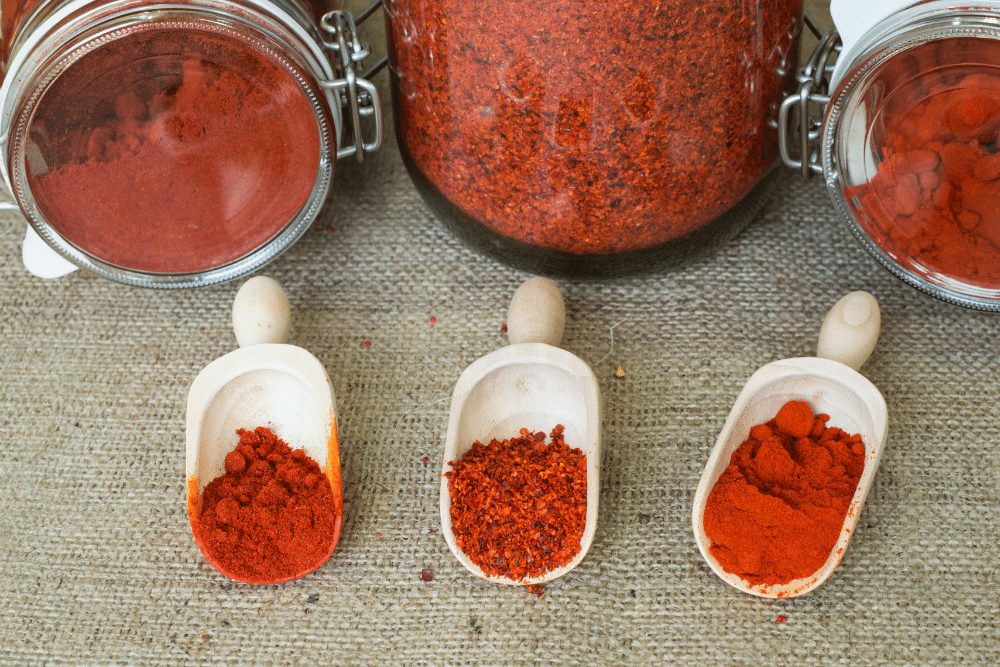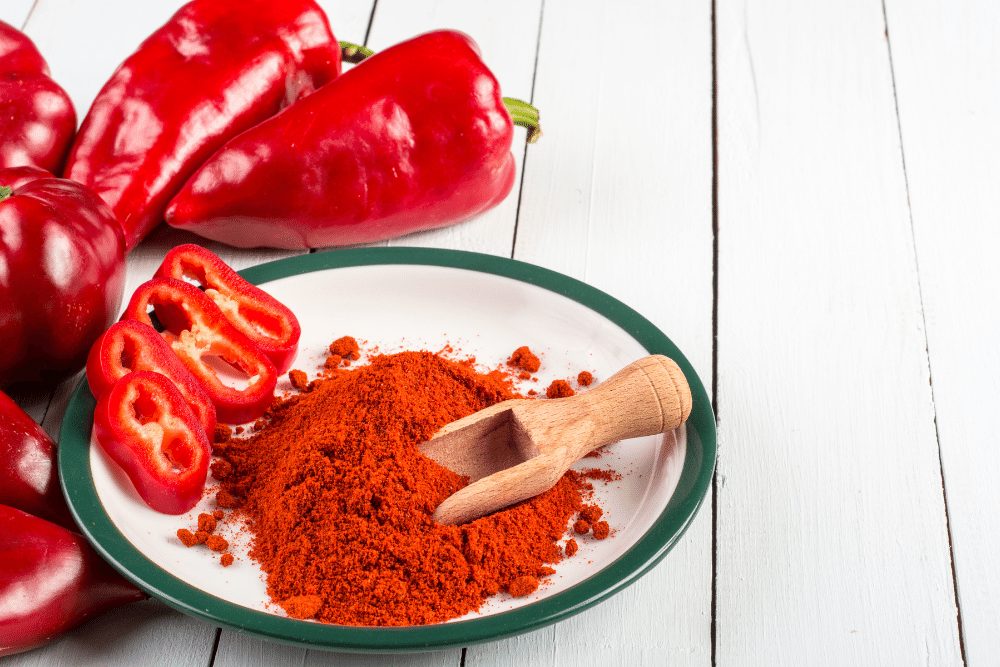Sweet paprika is a highly versatile dry spice blend using ground red peppers. Paprika comes in sweet, hot, or smoked varieties. It is prevalent in Hungarian cuisine, but it is used worldwide to add a mild sweetness and bright red color to dishes.
What Is Sweet Paprika?
Sweet paprika is a dry orange-red spice obtained from different dried red peppers ground into a fine powder. It is mild in flavor and has a pleasant sweetness since it’s made with sweet red peppers, not hot peppers.
What Red Chili Peppers Are Used In Sweet Paprika?
Traditionally, sweet paprika is a blend of different varieties of fruits in the Grossum Group of the Capsicum annuum species.
The Grossum Group produces sweet peppers, while the Longum Group of the species features hot chili peppers, like cayenne. The “sweet pepper” term is an umbrella for varieties of pepper that have a sweet flavor and zero-to-mild heat.
The most prevalent cultivar in the Grossum Group is bell peppers, which explains why red bell peppers are the most commonly used in sweet paprika. Bell peppers are also the most common type of sweet peppers and are thus equated with “sweet peppers.”
Other Grossum Group sweet peppers used in sweet paprika include banana peppers (0-500 SHUs), pimento peppers (100-500 SHUs), and “Sweet Cherry” cherry pepper (about 500 SHUs).

The bottom line is that for a chili pepper to feature in sweet paprika, it has to fulfill two essential requirements: it must have a bright red color at full ripeness, and it must be sweet (low scores on the Scoville Scale). The sweetness of the peppers peak at full maturity or ripening.
Sweet paprika may feature different red chiles, depending on the region and manufacturer.
For example, cherry paprika is common in Hungary and is made with “Sweet Cherry” cherry pepper—a cultivar of the hotter cherry peppers (500-3,500 SHUs) developed by Hungarian chili farmers. Pimento peppers (not to be confused with cherry peppers) are commonly featured in sweet paprika in Spain and the US.
Is Sweet Paprika Spicy?
Sweet paprika is not spicy but rather pleasantly sweet or fruity, with slight hints of bitterness and tartness.
What’s The Difference Between Regular Paprika, Sweet Paprika, Hot Paprika, And Smoked Paprika?
In most grocery stores and supermarkets, you’ll find containers labeled “paprika” with no qualifying definitions. This often means two things: the spice inside is regular paprika or sweet paprika.
In fact, both regular paprika and sweet paprika are usually used as interchangeable terms.
However, using sweet and regular paprika to substitute for each other is not advisable. Regular paprika, also called basic or generic paprika, is often a run-of-the-mill product in most regions. It is without any heat and flavor, meaning it’s mainly used as a food color.
On the other hand, sweet paprika is bright and flavorful.
Most online spice outlets will have sweet paprika labeled as such. It’s usually easier to buy sweet paprika from online stores for recipes requiring the sweet version.

While sweet paprika is made with ground bright red dried sweet peppers with no heat, hot paprika is made with ground dried hot red peppers.
Hot paprika uses red peppers ranging from mild to high heat and is thus spicier but less flavorful than sweet paprika. It is usually used as a complementary spice to sweet paprika to add heat to a dish while retaining the sweetness of sweet paprika.
Hot paprika is regarded in the culinary world as the most superior of all the three kinds of paprika. This is especially so if it is from Hungary, which earns it the term (hot) Hungarian paprika.
The last of the three paprika types is smoked paprika, also called smoked Spanish paprika or smoked pimentón.
Smoked paprika is made with dried sweet red peppers, or dried hot red peppers smoked using an oak fire. However, not all paprikas from Spain are dried over an oak fire; some are dried under the sun or in a commercial dehydrator and thus have no smoky flavor.
The use of sweet peppers or hot peppers leads to distinct heat levels and classifications of smoked Spanish paprika:
- Sweet smoked paprika, or pimentón dulce, is made with the mildest red peppers. It is mild and fruity, like non-smoked sweet paprika.
- Bittersweet smoked paprika or pimentón agridulce is usually made with jariza pepper and has a semi-spicy flavor, between hot pimentón and sweet pimentón
- Pimentón picante, or hot smoked paprika, is a lot spicier and is made using different smoked, hot dried chili peppers.
- Pimentón de la Vera from La Vera in Spain is stone-ground after being smoked specifically over an oak fire.
What Can Be Substituted For Sweet Paprika?
If you can’t find sweet paprika, consider these substitutes:
- Regular/plain/basic/generic paprika, which is the closest substitute but is less flavorful than sweet paprika.
- Chipotle powder for sweet flavor, smokiness, and mild spiciness,
- Cayenne pepper, which is hotter than sweet paprika, so add sugar or honey to mimic the sweetness.
- Hot sauces, such as Tabasco sauce, made with hot chili peppers (hotter than sweet paprika).
- Chili powder, which is hotter than sweet paprika and has other spices like garlic, oregano, and cumin.
- Cajun spice, a mixture of many spices and herbs.
- Achiote, annato seeds used primarily as a food coloring.
Hungarian Sweet Paprika Versus Spanish Paprika
Both Spanish paprika and Hungarian sweet paprika are made with dried, ground sweet red peppers.
Hungarian noble sweet paprika or Édesnemes is one of the eight grades of Hungarian paprika used in Hungarian cuisine using sweet red peppers. The vibrant red paprika is available in most other countries as it is the most exported grade of Hungarian paprika.
Spanish paprika, on the other hand, may be smoked or sun-dried. It is available in different forms, including:
- Sweet smoked Spanish paprika
- Pimentón agridulce
- Pimentón picante
- Pimentón de la Vera
- Dulce (Sweet) sun-dried/non-smoked Spanish paprika
- Agridulce sun-dried Spanish paprika
- Picante sun-dried Spanish paprika
Sweet Paprika In Cooking
If you can’t wait to try some sweet paprika recipes, here are some ideas on how to use the versatile and colorful seasoning.

- Making homemade ketchup
- Flavoring soups, meat rubs, rice, snacks, and stews
- Adding to marinades and sauces
- Making sausages
- Adding to some dishes to reduce hotness or balance out intense flavors of other spices, especially those that have tangy and earthy flavors
- Sprinkling as a garnish on deviled eggs, hummus, potato salad, and macaroni salad
- As a food coloring agent with bright flavor compared to regular paprika powder
- Seasoning popular Spanish and Hungarian dishes like Spanish paella, chicken paprikash, fried chicken, and goulash

